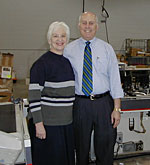
Middle Class Warning Signs
by Bill Catlin
April 2000
With each passing day, the U.S. economy sets a record for the longest economic
expansion. Mark your calendar. These are the good old days.
Unemployment is down. Wealth is up. But even as the digital revolution mints new
millionaires daily, some see warning signs for the middle class.
 |
 |

|
Sandy and Ron Weislow started Communication Mailing Services in St. Paul,
after Ron was laid off from Control Data 14 years ago. The business now
employs more than 40 people and sales are expected to exceed $2 million
this year.
Click here for larger image.
|
|
 |
| |
RON AND SANDY WEISLOW
feel like they're living the American dream.
In December of 1985, Sandy Weislow was teaching Spanish in the St. Paul public
schools. Her husband Ron, a 49-year-old manager for Control Data, was about
to become one of the thousands the struggling company laid off. "It was the Friday that winter break started," Sandy recalls. "I came in from school, and
there he was in the kitchen, and I went, 'What are you doing here?' And he said,
'I got my pink slip.' I said, 'You're kidding,' and he said, 'No,' and he showed
it to me. So, we said, 'Okay.' And we went for a walk that night, and it was
snowing like the devil, and I said we're going to make it or break it now."
The Weislows launched Communication Mailing Services to fill what Ron
thought was a need in St. Paul for someone to process bulk mailings. Today,
their facility resonates with the clacks and clicks of complex and expensive
machines; some fold flyers, others stuff them in envelopes or print mailing
addresses. Sandy recalls that Ron initially thought they wouldn't have to pay
for a lot of pricey equipment.
"Ronny said, 'Well, this is what we need, because I've been in this business
and all we need are three small machines. That's all we need, honey. And we'll go
from there.' I said, 'OK.' And he gave me the price. You went out the
next week, and started pricing, and he came back, and I ... It was like an ice
pick in my eye, and I said, 'OK, but we can do it.'"
The budding business survived the stock market crash of 1987, and the recession
of 1990 and '91. Sandy spent seven years both teaching and helping the new business
before she felt safe leaving the classroom to join Ron full time.
"The first five years were just hell, to be honest," Ron recalls, laughing about it now.
The Weislow's story reflects key forces in the long economic boom. They built a
business from an idea, and now provide jobs for more than 40 people. Sales have
grown by at least 20 percent a year, and are expected to exceed $2 million
this year. Entrepreneurs like the Weislows have played a major role in
fueling economic growth and soaring stock prices. And the run up in stock prices
has improved the typical family's balance sheet.
More families own stock and their holdings are worth more. From 1992 to 1998,
the median net worth of all families jumped by more than one quarter to nearly
$72,000. Louis Johnston, assistant professor of economics at the
College of St. Benedict and St. John's University, says the rising popularity of
401(k) retirement plans has helped make us a nation of investors.
"This allows people to move their money around, and put it into whatever asset
they want, a stock, a bond," Johnston says. "So people pay attention. They watch the financial
pages. They do things like day trading. They actually participate in a way that
only the "fat cats" used to."
 |
 |

|
Dale Hedtke, owner of the nearly two-year-old Boat-House in St. Paul says
boats are flying off the racks. Sales are running at more than twice the
rate he expected.
Click here for larger image.
|
|
 |
| |
With the bull market has come higher consumer confidence and more spending on
big-ticket items like jewelry, airplanes and boats.
The trends are showing up at the Boat-House, Dale Hedtke's nearly two-year-old
shop in St. Paul, where he sells a variety of boats, including do-it-yourself
kayak kits for about $800.
Hedtke marvels that sales are so brisk. "We're selling boat kits, and ready made boats, and vintage boats, and antique outboards, and sailing materials, and it's just
crazy."
Hedtke says the economy is providing a nice tail wind.
"I don't have people coming in and saying, 'Oh, we feel real good about business.'
But you just can see it in their overall attitudes. They're feeling like they
have the disposable income, they've got some time to do some building, or at
least take some trips."
The booming economy is pushing people into higher income brackets, and the
ranks of people earning less than $25,000 a year are slowly
thinning. Economist Louis Johnston says since the early 1980s, most income gains
went to the top wage brackets, but since 1995, the rising tide is lifting boats
in the middle. " Since the mid 1990s, with productivity growth improving, middle class incomes have at worst stayed the same," says Johnston. "So they've not gotten any lower than they were 20 to 30 years ago, and they've actually started to expand."
Census bureau figures indicate average household income has risen across the
board from 1995 to 1998. In the first half of the decade, income levels were
flat or down slightly for all but the top 20 percent. ( See Charts )
But Cornell University economist Robert Frank looks at the data and sees a
middle class under growing financial pressure.
"The boom has been a wonderful thing in many ways, but it hasn't showered
benefits equally upon everyone," says Frank.
Frank says while a larger percentage of people own stock, and those holdings are
worth more, people in the middle just don't own a lot of stock. Gains have been
concentrated in households with incomes above $50,000. And Frank
contends the purchasing power of middle income earners hasn't changed much since
the 1970s.
At the same time, he says the rising wealth and spending at the top pressures
people in the middle to spend more to keep up. Frank notes that the average new
house size has grown since the 1970s when it was 1,500 square feet. "Last year the average new house built in the United States was 2,200 square
feet, and that means someone with essentially the same purchasing power had to
buy a 50-percent-larger house. So that's extra financial stress on the person in
the middle, however you slice it."
In the last three years, Americans have taken on more debt, are spending more of
their income to pay it off, and more people are in debt-related financial
distress according to the Federal Reserve.
Even Fed chairman Alan Greenspan, who many regard as chief architect of the
current prosperity, notes that rapid technological change is fueling workers'
fears about their jobs. ( Read more) In spite of tight labor markets, worker insecurity is
greater than during the depth of the 1991 recession.
But many more statistics point to an economic zeitgeist that's more zoomy than
gloomy. Along with the stock market, luxury spending, and home ownership are up,
as is consumer confidence, though it's slipped recently. Black teen unemployment
and inflation are down. The prevailing mood is more like the Weislows, who feel
they can relax and enjoy life more.
"Now, everything is always, 'where are we going, where are we
going next, what are we doing, how do we grow?' Not 'how do we stay in business?'," Ron Weislow says.
![]()
![]()
![]()

![]()
![]()
![]()

![]()
![]()
![]()
![]()
